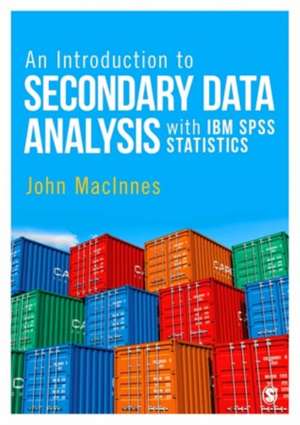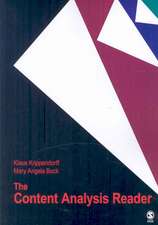An Introduction to Secondary Data Analysis with IBM SPSS Statistics
Autor John MacInnesen Limba Engleză Paperback – 18 dec 2016
You will learn how to:
- Create a robust research question and design that suits secondary analysis
- Locate, access and explore data online
- Understand data documentation
- Check and 'clean' secondary data
- Manage and analyse your data to produce meaningful results
- Replicate analyses of data in published articles and books
| Toate formatele și edițiile | Preț | Express |
|---|---|---|
| Paperback (1) | 361.26 lei 3-5 săpt. | +32.13 lei 7-13 zile |
| SAGE Publications – 18 dec 2016 | 361.26 lei 3-5 săpt. | +32.13 lei 7-13 zile |
| Hardback (1) | 983.86 lei 6-8 săpt. | |
| SAGE Publications – 18 dec 2016 | 983.86 lei 6-8 săpt. |
Preț: 361.26 lei
Nou
Puncte Express: 542
Preț estimativ în valută:
69.13€ • 72.17$ • 57.21£
69.13€ • 72.17$ • 57.21£
Carte disponibilă
Livrare economică 14-28 martie
Livrare express 28 februarie-06 martie pentru 42.12 lei
Preluare comenzi: 021 569.72.76
Specificații
ISBN-13: 9781446285770
ISBN-10: 1446285774
Pagini: 336
Dimensiuni: 184 x 246 x 19 mm
Greutate: 0.61 kg
Ediția:First Edition
Editura: SAGE Publications
Colecția Sage Publications Ltd
Locul publicării:London, United Kingdom
ISBN-10: 1446285774
Pagini: 336
Dimensiuni: 184 x 246 x 19 mm
Greutate: 0.61 kg
Ediția:First Edition
Editura: SAGE Publications
Colecția Sage Publications Ltd
Locul publicării:London, United Kingdom
Recenzii
'For a generation we have been waiting for a really good introduction to secondary data analysis. This is it.'
‘A concise, compelling and engaging new text, this is a valuable addition to the bookshelves of anyone wanting to really get to grips with secondary data analysis.’
‘An excellent text that engages with the real-world practice of analysing existing quantitative data resources. The book covers the neglected issues of data documentation, data management, and replication that are central to effective research.’
‘There are lots of books about statistics. But there are very few that tell students what they really need to know: how to acquire and manage data, and how to use them to answer questions relevant to their studies. This book fills the gap in a clearly written and user-friendly way, and is full of interesting and practical examples. It should be core reading.’
'MacInnes shows newcomers the possibilities before them and teaches the safeguards needed to make the most of secondary data.’
'Accessibly written, this is a friendly and indispensable companion for any student embarking on a secondary data analysis project. A breath of fresh air.’
‘A concise, compelling and engaging new text, this is a valuable addition to the bookshelves of anyone wanting to really get to grips with secondary data analysis.’
‘An excellent text that engages with the real-world practice of analysing existing quantitative data resources. The book covers the neglected issues of data documentation, data management, and replication that are central to effective research.’
‘There are lots of books about statistics. But there are very few that tell students what they really need to know: how to acquire and manage data, and how to use them to answer questions relevant to their studies. This book fills the gap in a clearly written and user-friendly way, and is full of interesting and practical examples. It should be core reading.’
'MacInnes shows newcomers the possibilities before them and teaches the safeguards needed to make the most of secondary data.’
'Accessibly written, this is a friendly and indispensable companion for any student embarking on a secondary data analysis project. A breath of fresh air.’
Cuprins
Chapter 1: Secondary Data Analysis: The Evidence is Out There
Chapter 2: Understanding the Basics of Statistics
Chapter 3: Doing Secondary Data Analysis in Five Minutes
Chapter 4: Getting Started with SPSS
Chapter 5: Dealing with Data Documentation
Chapter 6: Replicating Published Analyses
Chapter 7: Preparing Your Data
Chapter 8: Managing and Manipulating Data
Chapter 9: Introducing Linear Regression
Chapter 10: Getting Started with Logistic Regression
Chapter 11: Using Binary Logistic Regression
Chapter 12: Practising Regression Skills With Replication
Chapter 13: A Look Back: How to Enjoy ‘An Avalanche of Numbers’
Chapter 2: Understanding the Basics of Statistics
Chapter 3: Doing Secondary Data Analysis in Five Minutes
Chapter 4: Getting Started with SPSS
Chapter 5: Dealing with Data Documentation
Chapter 6: Replicating Published Analyses
Chapter 7: Preparing Your Data
Chapter 8: Managing and Manipulating Data
Chapter 9: Introducing Linear Regression
Chapter 10: Getting Started with Logistic Regression
Chapter 11: Using Binary Logistic Regression
Chapter 12: Practising Regression Skills With Replication
Chapter 13: A Look Back: How to Enjoy ‘An Avalanche of Numbers’
Notă biografică
From 2009 to 2014 John was the Strategic Advisor to the Economic and Social Research Council (ESRC) on quantitative methods training overseeing the genesis and launch of the Q-Step programme. From 2015 to 2020 he was Strategic Advisor to the British Academy on Quantitative skills and a member of the British Academy¿s High Level Strategy group on Quantitative Skills. John is a Chartered Statistician and was Vice President (Professional Affairs) of the Royal Statistical Society 2019-20. He has held research grants from the European Commission, UK ESRC, British Academy, Leverhulme trust and British, Spanish and Catalan government departments.
Descriere
John MacInnes takes the fear out of statistics for students, and helps to raise the standards of their quantitative methods skills, by clearly and accessibly introducing all that’s needed to know about using secondary data and working with IBM SPSS Statistics.








